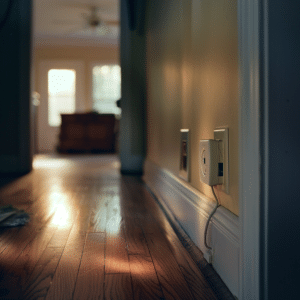When a child is shocked by an outlet, prompt and accurate response is essential. This article cuts straight to vital information on what to do if your child gets shocked by an outlet, providing you with a quick and authoritative guide to navigating this emergency with composure. Without fluff, we walk you through emergency response, assessment, and aftercare—all aimed at your child’s immediate and long-term safety.
Key Takeaways
- Immediate action during an electric shock incident for a child involves disconnecting the power source without direct contact with the child, assessing their condition, and seeking emergency medical help if they are unresponsive or the shock was severe.
- Symptoms of an electric shock include difficulty in breathing, altered skin color, seizures, and burns, which may indicate the extent of external and internal injuries that require prompt professional medical evaluation and treatment.
- Prevention of electric shocks entails childproofing your home by using safety devices on outlets, handling electrical appliances correctly, teaching children about risks, and ensuring your electrical systems are maintained by licensed professionals.
Immediate Response to Electric Shock in Children
When a child experiences an electric shock, seconds count. Your initial response can significantly impact the outcome of this frightening event. The first and foremost rule is to not touch the child if they are still in contact with the electrical source, as you could be shocked as well. Instead, your immediate priority should be to disconnect the power supply.
After ensuring the electrical current is no longer a threat, check whether moving the child is safe. This decision should be made carefully, as moving them improperly could potentially lead to further injury. If the child is unresponsive or the electric shock appears severe, don’t hesitate to call emergency services.
Assessing the Situation
When assessing the situation, remember to maintain your own safety. Avoid direct contact if the child is still connected to the electrical source to prevent the electric current from passing through you. Check for wires or other conductive materials that may be touching the child to determine if they are still in contact with the electrical source.
Next, check for the child’s responsiveness and consciousness as this can help assess the severity of the electric shock injury, which could range from a mild electric shock to a more severe one. Also, take a moment to visually inspect the area for potential risks like exposed wires, water presence, or damaged electrical outlets that could escalate the situation.
Disconnecting the Power
Disconnecting the power is a critical step to ensure both your safety and that of the child. Turn off the power to the electrical outlet before approaching the child who is still in contact with the electrical source. If turning off the main power source is not possible and the child is still experiencing an electric shock, use rubber gloves or a nonconductive item to move the child away from the source.
Remember, the goal here is to stop the electric current from flowing through the child without putting yourself at risk. Using insulated materials like rubber gloves or wooden objects can safely push the child away from the electric source.
Seeking Emergency Help
Once the power is disconnected and the situation is under control, it’s time to seek medical help. If the child is unresponsive or if you suspect the electric shock is severe, call emergency services immediately. While waiting for help to arrive, try to keep the child calm and comfortable.
To provide the best possible care for your child in an emergency situation, follow these steps:
- Avoid moving the child unnecessarily as this could potentially worsen any injuries.
- Focus on keeping them warm and reassured.
- Remember, emergency services are equipped with the necessary knowledge and equipment to handle such situations and can provide the best possible care for your child.
Symptoms of Electric Shock to Recognize
 Recognizing the immediate symptoms of an electric shock in children is crucial for swift and effective medical intervention. Symptoms can include:
Recognizing the immediate symptoms of an electric shock in children is crucial for swift and effective medical intervention. Symptoms can include:
- Difficulty breathing
- Skin color changes
- Reduced alertness
- Seizures
- Difficulty staying awake
If you notice any of these symptoms after an electric shock, seek medical help immediately.
Muscle spasms, for instance, are a specific symptom directly resulting from an electric shock. Moreover, effects on the nervous system, such as pain and difficulty moving limbs, should be monitored as they can indicate internal damage from an electric shock. Understanding these symptoms can help you better communicate the situation to medical professionals, enabling them to provide the most effective treatment.
Visible Injuries and Burns
Visible injuries and burns from an electric shock can provide significant insight into the severity of the injury. Entry and exit points of electrical burns on the skin may appear painless and superficial, but they can signify more severe internal injuries. Even mouth burns resulting from biting an electric cord might seem less severe initially but may require surgical intervention after preliminary healing.
It’s essential to remember that electrical injuries can extend beyond visible skin burns, leading to the damage of tissues and organs within the human body. Therefore, vigilance in monitoring for any signs of internal harm is critical in the aftermath of an electric shock.
Internal Damage and Cardiac Concerns
While visible injuries provide immediate indications of an electric shock, internal damage can be insidious. Electric shocks can cause severe internal damage, potentially affecting the:
- Heart
- Kidneys
- Muscles
- Nervous system
This can happen even with low voltage. Because of the potential for internal damage that isn’t immediately apparent, a child who has received an electric shock should be examined by a pediatrician.
Electric shock can lead to serious cardiac risks, including cardiac arrest, arrhythmia, and ventricular fibrillation, which can be life-threatening. If the electric current passes through the chest area, the risk of arrhythmias and cardiac arrest is heightened. The severity of damage from an electric shock depends on various factors, including the type of current, the type of tissue it passes through, and the duration of contact with the current. Therefore, it is crucial to seek professional medical attention when an electric shock occurs.
Contact us today for your free & confidential case review. Our team will help you get the compensation that you deserve.
Aftercare Following an Electrical Injury
The care given after an electric shock is just as crucial as the immediate response. Because of the possibility of internal injuries that are not visible, it is essential to seek medical care immediately following an electrical injury. Even if the child appears well after the incident, unseen injuries such as muscle, heart, or brain damage, as well as bone fractures or organ trauma could result from being thrown from the electric source.
Furthermore, treatment following an electric shock may involve surgery to clean wounds or perform skin grafting, and severe burns on limbs may require amputation or other surgical interventions. This underscores the seriousness of electrical injuries and the importance of immediate and adequate medical attention.
Monitoring for Delayed Symptoms
The effects of an electric shock may not be immediately apparent, and delayed symptoms can develop over time. These can include:
- Tingling
- Numbness
- Weakness
- Pain
- Difficulty moving a limb
These symptoms may or may not resolve with time. In some cases, they can become permanent.
Long-term effects on the brain or nerves can develop months after the electric shock, thus requiring ongoing observation. Therefore, it is crucial to keep an eye out for these symptoms and seek medical help if they appear, as they could indicate a more serious underlying condition.
Addressing Psychological Impact
The impact of an electric shock isn’t just physical; it can also have psychological effects. Psychiatric disorders such as anxiety or depression could be a delayed effect of an electrical injury. Therefore, it’s vital to monitor for signs of psychological shock in children, such as cool, clammy skin, and paler skin color, which may accompany physical injuries after an electric shock.
In addition, electrical damage to the brain can lead to long-term psychological effects, such as:
- A seizure disorder
- Changes in mood and personality
- Depression
- Anxiety
- Alterations in behavior
Being aware of these potential impacts can help ensure the child receives comprehensive care and support following an electric shock.
Your Home to Prevent Electrical Shocks
Prevention is always better than cure, and this is especially true when it comes to electric shocks. Approximately 30,000 non-fatal electric shock injuries occur annually in the United States, with about 20% involving children. These figures highlight the importance of childproofing your home to prevent such accidents.
This involves implementing safety measures such as using child safety covers on electrical outlets and putting away extension cords and electrical appliances when not in use. By taking these steps, the risk of electrical injury can be significantly reduced, providing a safer environment for our children.
Safety Devices for Electrical Outlets
One of the most effective ways to prevent children from accessing electrical outlets is by installing safety devices. Tamper-proof receptacles, for instance, are designed to prevent electric current from flowing unless all slots are activated simultaneously. Similarly, modern 13A plug sockets have built-in safety features such as pinhole shutters, reducing the need for additional socket covers.
However, it’s a common misconception that socket covers provide additional safety. If inserted incorrectly, they may pose more danger by exposing live parts, contrary to the built-in safety of modern sockets. Therefore, it is crucial to choose the right safety devices and use them correctly to ensure your child’s safety.
Safe Handling of Electrical Appliances
Handling electrical appliances safely is another critical aspect of preventing electric shocks. Power strips should be covered to prevent children’s access, reducing potential electrical injuries. Also, electronic devices should not be charged on beds or under pillows to prevent overheating and fire risks.
Furthermore, loose electrical cords should be secured to minimize tripping hazards and discourage children from playing with them. By taking these measures, you can ensure that your home appliances and their electrical cord do not pose a risk to your children’s safety.
Educating Children About Electrical Safety
 Education is a powerful tool for prevention. Children must be taught:
Education is a powerful tool for prevention. Children must be taught:
- Not to bite electrical cords or insert any objects into outlets, as such actions can result in electric shocks
- To avoid putting metal objects in toasters
- To keep water away from appliances like hairdryers
- Never to use fake chargers
These measures help ensure electrical safety for children when using electrical devices near power lines.
It’s important to educate children early about not using electrical appliances near water to prevent accidents and to make them aware of the hazards associated with non-genuine electrical accessories. By doing so, you can empower your children with the knowledge they need to stay safe.
Ensuring Electrical Systems Safety
While childproofing and education are essential, maintaining the safety of your home’s electrical systems is equally important. Licensed electricians are crucial for maintaining electrical safety, due to their specialized training and knowledge in electrical systems. They can reveal and fix electrical hazards such as damaged wires or malfunctioning electrical equipment to enhance household safety.
Trained electricians can also undertake the installation of critical safety features, including circuit breakers and surge protectors, reducing the risk of electrical incidents. Remember, ensuring the safety of your electrical systems is a proactive step towards preventing electric shocks.
Frequently Asked Questions
What immediate steps should I take if my child gets an electric shock?
What are the symptoms of electric shock in children?
How can I prevent electric shocks in my home?
What is the importance of a licensed electrician in maintaining electrical safety?
Can an electric shock have psychological effects on a child?
Last updated Wednesday, September 18th, 2024












